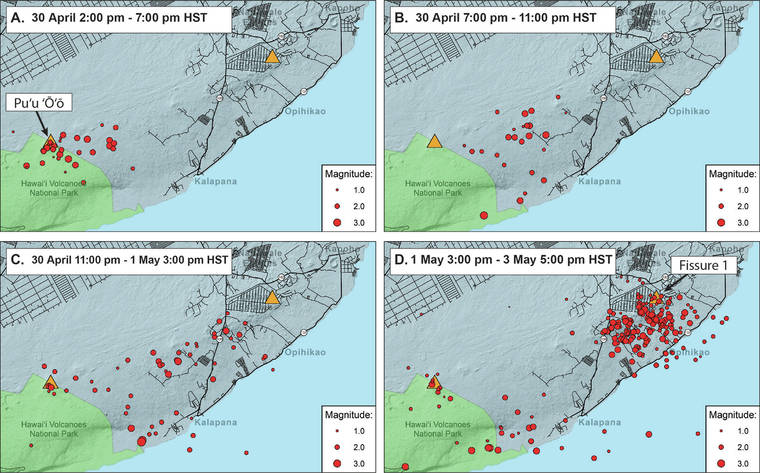When a major geologic event occurs, scientists who study such events and the people directly or indirectly impacted by it seek to understand its cause.
Often, a first step toward that understanding is to rule out what did not cause the event.
The USGS Hawaiian Volcano Observatory has received several inquiries about the cause of Kilauea Volcano’s 2018 lower East Rift Zone eruption. Specifically, we’ve been asked if the eruption was caused by or related to geothermal drilling and energy production on Kilauea’s East Rift Zone.
The short answer is “no” — there is no credible model that connects geothermal operations to Kilauea’s 2018 eruption.
We’ll explain by starting with some facts about the volcano.
First and foremost, Kilauea is one of the most active volcanoes in the world. The exposed part of the volcano covers itself with new lava every thousand years or so. Thus, it’s a matter of “when” — not “if” — an eruption will occur on Kilauea.
The rift zones and summit on Kilauea (and Mauna Loa) are identified as Zone 1 on the USGS Lava-Flow Hazard Map for Hawaii Island, which is where the majority of erupting vents have been located in recent centuries. These areas are the most dangerous because, in nearly all Hawaiian eruptions, lava has first emerged from the ground within Zone 1 and quickly flowed into Lava Flow Hazard Zone 2.
By April 2018, Kilauea had been erupting essentially nonstop for more than 35 years.
It was inevitable that, at some point, the Pu‘u ‘O‘o eruption would end and another eruption would begin on the volcano.
It was also fairly certain that, based on past activity, the next eruption would likely occur somewhere on Kilauea’s East Rift Zone.
Seismic and deformation data from the 2018 eruption show that magma was injected into the lower East Rift Zone from the middle part of Kilauea’s East Rift Zone near Pu‘u ‘O‘o between April 30 and May 3.
A National Oceanic and Atmospheric Administration animation depicts the earthquakes that occurred on Kilauea during that time. These earthquakes propagated eastward at a pace of about 1 km per hour (0.6 mi per hour) throughout three days as magma forced its way through subsurface rock, until erupting to the surface as fissure 1 on May 3.
It clearly shows that the downrift migration of magma began near Pu‘u ‘O‘o rather than in the LERZ.
The initial intrusion of magma stopped beneath Pohoiki Road southwest of the geothermal development. On May 9, seismicity indicated the intrusion had reactivated and was moving eastward toward Kapoho. After another short pause, the magma continued its subsurface advance until it reached its easternmost point near the south end of Halekamahina Road.
The subsequent opening of 24 fissures in the vicinity of Leilani Estates on Kilauea’s LERZ was not unprecedented or particularly surprising.
Eruptions occurred in this same area in 1960 (Kapoho), 1955 (steam vents on Highway 130 to Halekamahina), 1840 (Ka‘ohe Homesteads through Nanawale Estates), about 1790 (Lava Tree State Monument) and earlier. These previous eruptions happened well before geothermal operations began on the LERZ.
The final locations of fissures 16-22 have led some people to ask if there might be a relationship between the eruption and geothermal operations. These operations are located on the LERZ because past eruptions produced a small hydrothermal resource deep beneath that area.
The combination of repeated pre-geothermal LERZ eruptions (1790, 1840, 1955, and 1960), the clear movement of magma from Pu‘u ‘O‘o into the LERZ and the temporary halt in magma propagation west of the geothermal development all indicate that geothermal operations played no discernible role in triggering the eruption.
The actual causes of the LERZ eruption are likely the pre-eruption build up of magmatic pressure at Kilauea’s summit combined with long-term weakening of the rift zone. The relationship between magma supply, magmatic pressure and strength of the volcanic edifice are the typical culprits for most volcanic eruptions around the world.
Impacts of the LERZ eruption were devastating, but the reason for the lava flow is no simpler than the fact that we live on an active volcanic island. What happened in 2018 is part of Kilauea’s natural process and was not influenced by human actions.
The volcano behaved as it has many times in the past.
Volcano activity updates
Kilauea Volcano is not erupting and its USGS Volcano Alert level remains at Normal.
Rates of seismicity, deformation and gas release have not changed significantly during the past week. Deformation signals are consistent with refilling of Kilauea’s deep East Rift Zone magma reservoir. Sulfur dioxide emission rates on the ERZ and at Kilauea’s summit remain low and have been steady during the past several months.
Four earthquakes with three or more felt reports occurred in Hawaii this past week, all on April 13: a magnitude-2.3 quake 20 km (12 mi) southeast of Waikoloa at 13 km (8 mi) depth at 6:12 p.m., a magnitude-2.6 quake 18 km (11 mi) east of Kalaoa at 15 km (9 mi) depth at 5:31 p.m.; a magnitude-3.0 quake 16 km (10 mi) northeast of Kalaoa at 14 km (9 mi) depth at 5:20 p.m. and a magnitude-5.3 quake 20 km (12 mi) east of Kalaoa at 13 km (8 mi) depth at 5:09 p.m.
Hazards remain at the lower ERZ and summit of Kilauea. Residents and visitors near the 2018 fissures, lava flows and summit collapse area should heed Hawaii County Civil Defense and Hawaii Volcanoes National Park closures and warnings.
HVO continues to closely monitor Kilauea for any sign of increased activity.
The USGS Volcano Alert level for Mauna Loa remains at Normal.
Visit HVO’s website (https://volcanoes.usgs.gov/hvo) for past Volcano Watch articles, Kilauea and Mauna Loa updates, volcano photos, maps, recent earthquake info, and more. Call 808-967-8862 for weekly Kilauea updates. Email questions to askHVO@usgs.gov.
Volcano Watch (https://volcanoes.usgs.gov/hvo/hvo_volcano_watch.html) is a weekly article and activity update written by U.S. Geological Survey Hawaiian Volcano Observatory scientists and affiliates.






